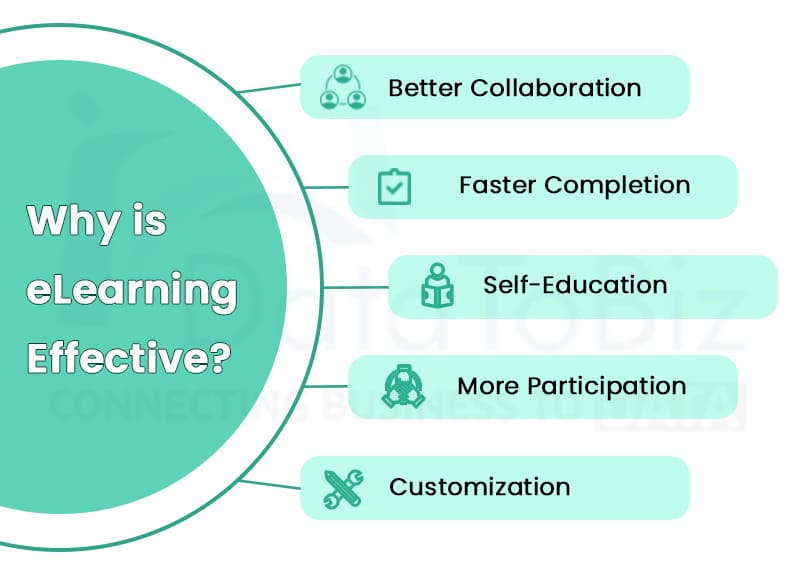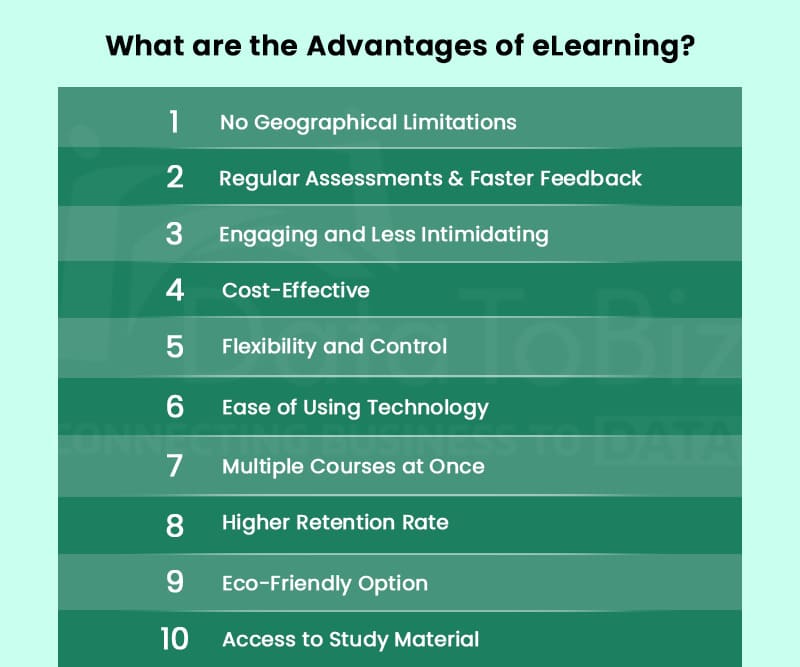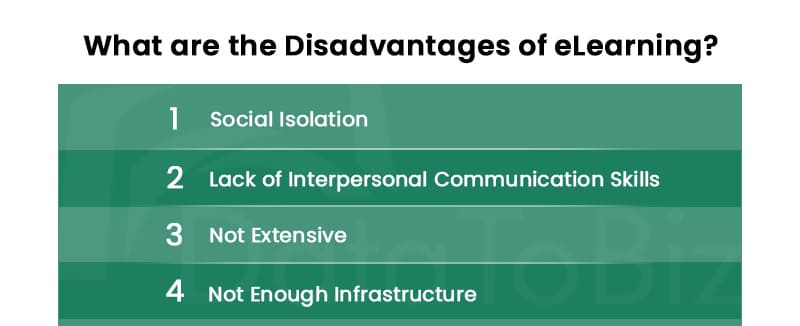eLearning or online learning is where students learn through a digital platform instead of going to school, college, or educational center to attend classes in person. Learning happens at a distance as opposed to traditional learning. Computers, laptops, tablets, smartphones, etc., are used for eLearning. An internet connection is a must for online learning.
The classes, however, can be live-streamed or recorded and shared. Communication apps like Zoom, Google Hangouts, etc., are used to teach a group of students at once. That said, eLearning through exclusive apps like Byjus, Duolingo, Extramarks, and many other EdTech platforms have revolutionized the educational industry.
Statistics suggest that the global eLearning market will reach $325 billion by 2025. Almost 80% of the corporates use eLearning solutions and 50% of the students have used an eLearning platform one time or another. Educational institutions in several countries are adopting eLearning as a part of their infrastructure.
So does this mean that online learning is better than traditional learning?
Well, online learning has many advantages over traditional learning. Whether it is the freedom to study according to one’s schedule or the access to lectures by experts in the domain irrespective of geographical restrictions, eLearning helps overcome the challenges faced by traditional learning.
Why is eLearning Effective?
The various advantages of eLearning make it an effective approach to impact education and empower more people from around the world. eLearning offers various benefits for students, teachers, and educational institutions. This has become a central element of the learning curriculum and has a significant role to play in creating equal opportunities for students.
It’s true that we still haven’t reached that stage, and there are several roadblocks to clear. However, many experts are positive that eLearning is an effective method to make education accessible to everyone, including the marginalized groups.

Better Collaboration
Most eLearning software comes with communication and collaboration tools. This helps students and educators interact in real-time. It majorly creates a similar environment as the classroom where students can talk to each other, albeit remotely.
Faster Completion
Teachers can plan their lessons using software applications and share study material with students through the internet. Unavailability of textbooks, notes, etc., won’t be a problem as teachers can create digital versions in less time. In fact, many universities (MIT OpenCourseWare is an example) already offer open-source material for teachers and students. Also, teachers can share pre-recorded videos for students to watch and learn when it’s convenient to them.
Moreover, the teacher can immediately conduct a test to assess the students’ knowledge of the topic before moving on to the next. AI-based platforms like PrepAI assist in generating question papers within minutes so the additional time otherwise consumed in creating various queries for a topic is saved.
Self-Education
eLearning empowers students to learn on their own with assistance from the faculty. The online videos, lectures, and study material provide students with the necessary support to educate themselves. The teacher will also find it easier to use technology in guiding and monitoring the students as and when necessary. They can pre-record videos, add answers to questions, or share comments with students. This reduces the pressure on teachers and helps students revisit the videos/ material without troubling the teacher every time. This is highly useful for people in remote areas with little or no infrastructure.
More Participation
The flexibility of online learning encourages more students to participate and join the classes. Students can attend classes even when they are traveling. They can watch the recorded videos at a later time. Students don’t have to miss a class because they can’t be physically present in the location.
Customization
Online learning allows educators to customize the teaching modules for different students. Unlike traditional teaching, eLearning doesn’t have to follow the one-for-all system where every student is taught the same way. The lessons and teaching methodologies can be customized based on students’ capabilities.
What are the Advantages of eLearning?
Let’s explore the advantages and disadvantages of eLearning. There are various advantages of online learning, ranging from affordability to eco-friendliness.

No Geographical Limitations
Students can attend lectures and seminars happening in any country simply by joining through the online link provided to them. Educational institutions don’t need to pay for an expert to visit their institution in another country. They can organize a webinar where the expert delivers the lecture from their existing location, and the students attend from wherever they are.
Regular Assessments and Faster Feedback
Conducting online assessments is easier for teachers as they don’t have to make the infrastructural arrangements. There’s no need to supply question papers or rearrange the students in the classroom.
Educators don’t have to spend extra time creating the question paper. They can use PrepAI or similar solutions to generate assessments in a few minutes, that too when teaching the class. Teachers can also provide immediate feedback by using technology to assess the test papers instead of going through each paper one by one.
Engaging and Less Intimidating
eLearning makes it less intimidating for students to attend classes. Research by California State University revealed that students who studied online felt less intimidated by the lessons and the faculty. Online students showed higher levels of participation compared to students who physically attended the classes.
Cost-Effective
Education is expensive in many countries. Paying the school/ college fee and a bunch of other fees puts students in debt, which takes years to repay. The maintenance of the campus and educational institutions is expensive for the management. eLearning provides a cost-effective alternative to both parties. An online course costs only a percentage of the fee students need to pay for traditional classes.
Flexibility and Control
Flexibility here refers to the subjects and courses students can choose for their online learning. The syllabus is different for traditional and eLearning. Students have more freedom to choose topics to add to their course.
Ease of Using Technology
In today’s world, most people rely on technology in one way or another. Students find it easier to rely on technology for learning. While teachers are not yet fully trained for online learning, the pandemic has put things in motion. Online learning also prepares students to be ready to enter the technology-dominant world without any extra effort.
Multiple Courses at Once
Students don’t have enough time to manage multiple courses when they have to physically attend classes at different locations.
But the same is easier through online learning. It enables them to complete classes at their convenience and enroll in different courses at once. This will help them improve their knowledge and skills in subjects that are not taught at their educational institution.
Even teachers and professors can share their expertise with students through online classes and videos. They can plan the courses effectively by creating videos and online classes on different topics.
Higher Retention Rate
The Research Institute of America found that student retention rates have increased between 25% and 60% for online classes. Teachers don’t have to deal with fidgety students in the classroom and can focus on imparting education. Using engaging forms of multimedia is the key to retaining students’ interest and increasing the retention rate.
Eco-Friendly Option
Online learning is an eco-friendly option compared to traditional learning and produces up to 86% fewer greenhouse gases. You save energy resources spent on going to the educational establishment, on building and maintaining the infrastructure, and the use of paper in daily classrooms.
Schools and universities rely on web hosting services (the servers have to be hosted on the cloud) to set up the eLearning system. Some of them are starting a trend by hiring web hosting companies with eco-friendly servers. This ensures that the establishment is minimizing the use of natural resources in different ways and is adopting the sustainable model. A lovely way to set an example to the students, isn’t it?
Access to Study Material
Another advantage of eLearning is access to study material. Teachers don’t have to worry about the lack of enough material for every student. Students don’t have to wait for libraries to provide the relevant textbooks. Many educational institutions nowadays are converting physical textbooks to digital copies and uploading them for students to download for free.
What are the Disadvantages of eLearning?

Social Isolation
Learning online means students don’t have face-to-face interactions with the teachers or other students. This can make them reclusive and socially isolate them from other people. The pandemic is another reason for social isolation. Educators need to create projects that encourage students to directly communicate with each other and work in teams.
Lack of Interpersonal Communication Skills
Online communication is different from in-person communication. Those used to online interactions find it awkward to handle face-to-face meetings. One way to overcome this is by organizing monthly/bi-annual meetings or events in educational institutions or nearest locations for students and teachers to meet in person.
Not Extensive
The eLearning industry is still evolving. That means all subjects and courses are not yet available as online courses. However, the increase in EdTech companies is ensuring that new subjects are included in the eLearning platforms. From science to arts to accounts, it won’t be long before eLearning becomes as extensive as traditional learning.
Not Enough Infrastructure
The remote areas don’t have enough facilities or infrastructure to help students join eLearning programs. Students and teachers from far-off locations need smartphones and access to the internet to reap the benefits of online learning.
Conclusion
The eLearning market has grown by 900% from 2000. Many educational establishments began to adopt eLearning during the pandemic. The increasing use of the internet is the main reason for this growth. Moreover, the advantages of online learning are hard to ignore.
EdTech companies take the responsibility of helping educational institutions with digital transformation and integrating their systems with eLearning platforms. PrepAI, developed by DataToBiz, has become a part of many such establishments. There’s no denying that eLearning is the future of the educational sector. Talking to EdTech solution providers can be one of the recommendations to provide quality online education to your students.




